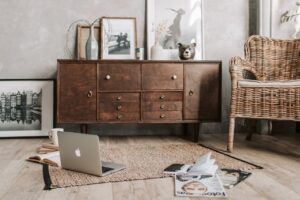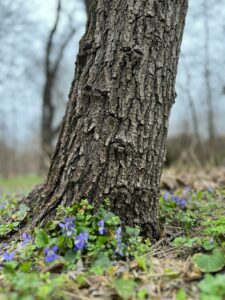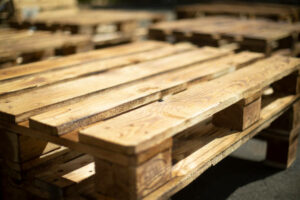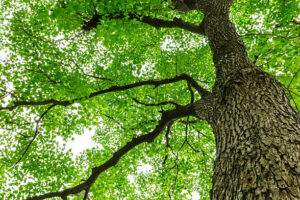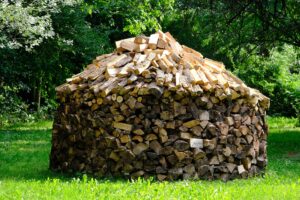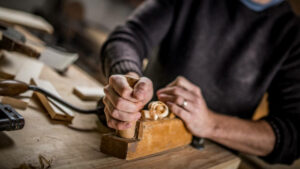When building structures that will be in or near a significant body of water or salt bottom, such as docks, boardwalks, piers, and sea walls, it’s important to use marine-grade lumber. This type of lumber is treated with chemicals to withstand constant contact with moisture and saltwater spray or submersion.
One of the benefits of pressure-treated marine lumber for use in construction projects located on or near significant bodies of water. The pressure treatment process fortifies the wood against mold, rot, and burrowing pests.
Features
While common pressure-treated (PT timber) wood is perfect for most outdoor construction projects, marine-grade PT lumber has extra protection and is ideal for any project that will be submerged or near a large body of water. Specifically, this includes docks, seawall components, and piers.
Marine lumber is encased in a polymer to protect it from moisture and saltwater. This process also allows the piling timbers to expand and contract naturally, eliminating the need for fasteners. The resulting material is extremely durable and lasts far longer than standard PT.
To make the most of the strength and longevity of marine PT, it’s important to use the correct hardware. Any hardware that comes in contact with the wood should be stainless steel, galvanized, or bronze to avoid corrosion. The type of preservative used in the PT lumber is another factor to consider. While CCA was once a popular option, newer preservatives like alkaline copper quaternary (ACQ) and copper azole are better for the marine environment now.
Another thing to keep in mind is that marine plywood does not undergo a chemical treatment to resist decay, as traditional PT lumber and plywood do. This means that if a piece of marine plywood is submerged in water, it will need to be coated with a waterproof sealant to prevent rot and mold growth.
Applications
Marine lumber can be used to construct docks, piers, and other structures in aquatic settings. It is a cost-effective alternative to concrete piling and can withstand the force of waves, wind, and other elements. It also offers flexibility, making it easier to install and adjust. Additionally, treated wood can accept a variety of fasteners, including nails, screws, and lag bolts.
The chemical preservatives used in pressure-treated wood can leach into the water and pose a risk to marine life. The type of preservative used and the treatment level are determined by the application for which the lumber is intended. This information is outlined on the end tag of each piece of lumber. To reduce the risk of harmful chemicals leaching into water, choose lumber that is treated for use in marine environments. Look for a classification of UC5B or UC5C on the lumber label tag, which indicates that the lumber can withstand prolonged exposure to salty or brackish water.
The process of treating lumber for marine, residential, and commercial applications can also weaken its strength by up to 15%. This means that if you’re planning on using the material for a structural project, consider alternatives such as wood-plastic composites or recycled plastic lumber. These materials don’t undergo the same process and won’t leak chemicals into the water or lose their strength over time.
Considerations
Wood requires significant treatment to withstand the constant moisture of marine environments. Whether it’s used for piles, docks, or piers, marine-grade lumber provides the necessary protection against pests and the elements to ensure structural integrity.
But despite its benefits for marine projects, pressure-treated marine lumber has its drawbacks as well. The chemicals that are used during the pressure-treating process can leach into the surrounding water, which poses a potential threat to nearby marine life. Thankfully, a growing number of homeowners are choosing to use alternative materials in their marine builds.
For example, a popular alternative to marine-grade plywood for commercial applications is marine plastic lumber. This alternative is made from recycled plastics, so it doesn’t undergo the pressure-treating process and will not deposit chemicals into the water. It also comes with a waterproof sealant that protects the boards from the elements and abrasions, so you don’t have to worry about it deteriorating over time.
When building your marine structure, choosing the right type of pressure-treated lumber for your needs is important. The American Wood Protection Association classifies 12 different levels of wood treatment, based on where you plan to put the structure, how wet it will be, and whether it’s intended for ground contact or above-ground use. Generally, you want to select lumber with a UC4A classification or higher, which indicates it is safe for marine construction.
Cost
The treatment process used to fortify natural wood against mold, rot, and pests adds cost to the material. Additionally, depending on supply and demand, prices can fluctuate. Labor shortages, issues with preservative chemicals, or transportation bottlenecks can all impact the pricing of this type of lumber.
Choosing the right marine-grade pressure-treated lumber is crucial to ensure longevity in water applications and durability in aquatic settings. Chromated copper arsenate (CCA) treated wood is the ideal choice for decks, exposed structures, and other applications near significant bodies of water. It looks more natural, resists corrosion from fasteners, and holds its color longer than many other outdoor preservative-treated products.
It’s important to select a lumber that meets the requirements set by your project’s environmental restrictions and building codes. Different projects put unique stresses on the wood, which dictates the level of preservative required to protect it from biological deterioration. We offer a variety of hazard grades and retention levels to meet your specific needs, including AWPA U1, UC4B, CC1-C, and CCA.
Unlike most common treatments of standard pressure-treated plywood, this product is crafted with Baltic birch plys throughout for added strength and durability. This plywood is also impregnated with waterproof glue to create a completely sealed surface and prevent voids and leaks.

